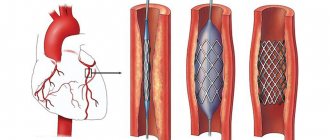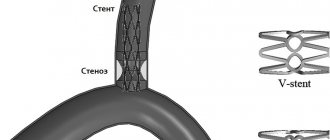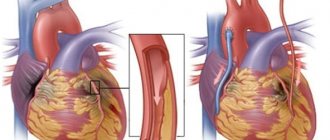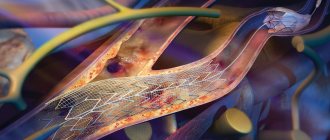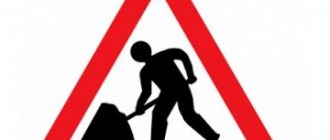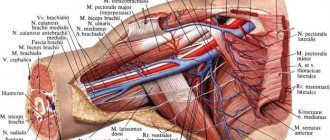Memo to a patient who has undergone coronary artery stenting
Atherosclerosis is a chronic progressive disease that leads to a decrease in blood flow in the supply area of the artery and oxygen starvation (ischemia) of the organ. Therefore, this disease is called coronary artery disease. If the coronary artery is narrowed, then symptoms of angina pectoris occur; if its lumen is completely blocked, then myocardial infarction occurs. This disease affects a large number of people around the world, incl. in our country. IHD is a leading cause of disability and death. Therefore, treatment of atherosclerosis and coronary heart disease is extremely necessary.
Damage to the coronary arteries can be suspected if characteristic chest pain appears during physical activity, changes during ECG and echocardiography. The most informative method for diagnosing damage to the arteries of the heart is coronary angiography. This study is carried out by puncturing the femoral or radial artery, passing a catheter through the hole to the vessels of the heart and injecting a contrast agent, one at a time, first into the right one. Then into the left coronary artery. The injected X-ray contrast agent, mixing with the blood, flows through the vessels, and at this time the X-ray machine is turned on and records the image in movie mode. After recording the entire series of images, the catheter is removed and the puncture site is pressed to stop bleeding. By assessing changes in the arteries, the X-ray endovascular surgeon can reliably say which treatment tactics can improve the patient’s quality of life - further drug therapy or invasive intervention (angioplasty with stenting or coronary artery bypass grafting).
Angioplasty and stenting of the heart arteries is currently the leading and most effective method of treating coronary heart disease due to a number of advantages:
- access does not require tissue incision and, accordingly, general anesthesia and associated complications;
- the patient communicates freely with the doctor during the entire procedure and usually does not experience any pain;
- The operation itself does not last long, and after it the person must remain in bed for 24 hours, and after a few days he can be discharged for outpatient treatment.
- This intervention can be performed several times throughout life as the disease progresses.
The essence of the technique is to expand the narrowed lumen of the vessel from the inside
a special balloon catheter, which is brought directly to the atherosclerotic plaque. By inflating a balloon selected to the size of the affected segment of the vessel, the plaque is crushed and the lumen of the artery is restored. To ensure that the artery segment remains dilated as long as possible, the arteries are strengthened by installing a special metal mesh tubular frame - a stent.
IMPORTANT! The effect of the intervention depends not only on what and how the stent is installed, but also on the patient’s further compliance with the following rules:
1. Strict blood pressure control
2. Quitting bad habits - smoking and alcohol
3. Regular exercise
With physical activity, blood supply to all organs and systems improves, the emotional state improves, weight decreases, and postoperative recovery accelerates.
4. Compliance with the principles of rational nutrition
- Limiting salt to 3-5 g/day (1 level teaspoon)
- Limiting animal fats (sour cream, fatty meats, poultry)
- Adequate dietary fiber intake
- Limiting cholesterol (offal, egg yolk)
- Consumption of vegetable oils (sunflower, olive, corn) - sources of omega-3 fatty acids
5. Learn to resist stress, avoid conflict situations and not create them
6. Strictly follow all prescriptions and recommendations of the doctor - regularly take medications and undergo prescribed examinations.
IMPORTANT! After stenting, the first step is to take medications that prevent the formation of blood clots: aspirin 75-100 mg/day. for life and clopidogrel 75 mg/day. at least 12 months.
IMPORTANT! You should also take statins, which significantly reduce mortality and the incidence of complications of coronary heart disease. In this case, the target values should be:
- total cholesterol less than 4.5 mmol\l
- low density lipoproteins less than 2.5 mmol/l
If symptoms of angina pectoris return, you should immediately consult a doctor.
It must be remembered that by strictly adhering to the recommendations, you can be sure of improving your quality of life for a long time.
Developed by the head of the RCC of the Central region Bolshovaya E.V.
Rehabilitation after stenting
Rehabilitation after stenting is a program that is based on the individual characteristics of the patient. It consists of exercises and activities whose goal is to restore health. Rehabilitation after stenting is divided into stages, which include physician-supervised exercises, development of the most optimal diet, emotional support, and training in the correct lifestyle. The cardiac rehabilitation program is aimed at restoring the body’s previous abilities, restoring lost strength, as well as preventing recurrent acute situations and heart complications in the future. Rehabilitation must begin as early as possible. The first stage is hospital . It is carried out in a hospital at the patient’s bedside. This may include breathing exercises and massage. Aimed at restoring blood flow in the vessels of the heart. The second stage is the recovery stage. The goal of this stage is to restore physical performance in order to return to work. Depending on how correctly, completely and intensively the rehabilitation measures are carried out depends on whether the patient will retain his ability to work. The third stage is outpatient . This is the supporting stage. It lasts a lifetime. It consists of maintaining the patient’s physical condition at the level that was achieved at stage 2. In patients after stenting, rehabilitation is carried out in several stages . 1- inpatient (cardiology or cardiac surgery department). 2- inpatient (rehabilitation department). 3- polyclinic or outpatient. In the Brest region there are rehabilitation departments in Brest, Baranovichi, Pinsk, Beloozersk . Referral to rehabilitation is carried out according to indications and in the absence of contraindications. After stenting, in the absence of complaints, able-bodied patients return to work and undergo rehabilitation on an outpatient basis. After stenting, you can undergo treatment in sanatoriums. The methods used to treat the cardiovascular system are based on various procedures. This can be heat therapy, dream therapy, hydrotherapy, phytotherapy, diet therapy, drinking oxygen cocktails. Climate therapy is of great importance in achieving positive results. This has a general strengthening effect and helps normalize cardiac activity. Sanatoriums for the treatment of the cardiovascular system in the Brest region: Nadzeya, Bug, Alesya, Belaya Vezha, Berestye, Chabarok. Svitanok. You can go to a sanatorium for treatment only when your condition has stabilized.
Physiotherapy
During the recovery period after myocardial infarction, physical therapy exercises are recommended. To speed up the rehabilitation process, it is important to start aerobic (which enriches the blood with oxygen) physical activity for 20 minutes.
Before starting physical exercise, you should consult a doctor. Self-study after a myocardial infarction should be started only within the time frame and volume specified by the doctor. In this case, exercises must be selected strictly individually and carried out under the guidance of an experienced specialist.
During the first few days, it is very important that the patient be monitored by the attending physician during exercise, monitoring his pulse, blood pressure and, if possible, recording an ECG.
In the future, if twenty minutes of physical activity is well tolerated and after consultation with a doctor, the patient can increase its duration to 30 minutes a day.
To calculate the target heart rate during exercise, there is a special formula: from the number 220 you need to subtract the patient’s age and calculate 70% of this number. For example, if the patient is 53 years old, 220 - 53 = 167. 70% of 167 = 117.
Therefore, to get the maximum benefit from exercise, a fifty-three-year-old patient should maintain his heart rate at 117 beats per minute for 30 minutes. And at the same time he should feel comfortable, and he should not have any cardiac complaints.
Prohibited Products
After stenting surgery, patients should completely limit their consumption of the following foods:
- coffee;
- cocoa;
- spices;
- chocolate;
- dairy products with high fat content (cream, sour cream, etc.);
- fatty meats (beef, pork);
- fatty fish (sardines, sprats, etc.);
- products made from puff pastry and butter dough;
- meat, mushroom, fish broths;
- canned and smoked foods;
- mayonnaise, margarine, butter.
How to avoid complications after stenting of heart vessels and coronary arteries
Patients most prone to complications after coronary artery stenting are those with various serious chronic diseases - kidney pathologies, diabetes mellitus, various disorders of hematopoietic and coagulation functions. Factors that increase the risk include old age and poor general condition of the patient’s body at the time of surgery.
In order to prevent the development of complications associated with the above reasons during coronary artery stenting, a thorough examination of the health status of the candidate for angioplasty is carried out even at the stage of preparation for the operation. This includes not only an assessment of the condition of the blood vessels, but also a comprehensive examination with attentive attention to all the patient’s complaints, taking into account all the medications he is taking and their possible reactions with medications administered during and after the operation.
When may stenting be needed?
There are several pathological conditions in which this intervention significantly improves the quality and life expectancy, and sometimes even saves. These are the diseases:
- stable angina;
- silent myocardial ischemia;
- acute coronary syndrome with and without ST segment elevation.
All of these are forms of coronary heart disease, which occurs due to partial or complete blockage of the lumen of the arteries that supply the heart muscle. The cause of such blockage is most often atherosclerosis.
Operation description
The essence of this intervention is that a special device, a stent, is inserted into the narrowed artery. Cardiac stenting surgery is endovascular. Before the operation, the patient must undergo tests and have an ECG and an X-ray of the lungs. Operation stages:
- local anesthesia is administered to the groin area (the place where the instrument is inserted);
- a special catheter is inserted into the lumen of the femoral artery, which will be used for manipulation;
- the catheter is gradually passed along the aorta in the direction of the heart, a radiopaque substance is injected through it so that the surgeon can see the condition of the arteries and the location of the catheter on the screen of the X-ray machine;
- Having reached the heart, the doctor injects contrast into the coronary vessels and determines where exactly the narrowing is located;
- A stent is placed in the narrowed area, which is expanded by inflating the balloon located in it.
Recommended Products
To lower the level of cholesterol in the blood and minimize the risk of developing atherosclerosis, ischemia and angina, it is necessary to include in the diet foods containing complex carbohydrates, fiber and polyunsaturated fatty acids. The daily menu should include:
- berries, vegetables and fruits;
- fresh herbs;
- dairy products;
- lean fish;
- seafood (seaweed, mussels);
- vegetable oil (olive or sunflower);
- poultry meat (chicken, turkey);
- lean meats (lamb, veal, lean beef);
- vegetable soups;
- cereal crops.
Decoctions of wheat bran and rose hips have a good effect on cardiac activity and blood circulation. Vegetable and berry juices are also useful.
Fully or partially limited products
All types of fatty meat, bacon, lard, any sausages, pates and meat pastes, as well as offal - liver, heart, brains - should be excluded from the diet. Broths containing meat, mushrooms and fish are prohibited. All fried foods, animal and cooking fats, mayonnaise and margarine are completely excluded from the diet. The consumption of butter, high-fat dairy products (sour cream, cream), and cheese is limited. Consumption of chicken eggs is limited to 3-4 eggs per week. You should not include fish and crustacean caviar, fatty fish (sprats, sardines) in your diet.
From the list of products you need to cross out white bread, confectionery, ice cream, carbonated drinks, as well as sugar and products containing it, honey. It is recommended to replace sweets with dried fruits. The restriction also applies to products with a high salt content (pickles, canned food, smoked meats). After vascular surgery, the consumption of chicken egg yolks, products made from butter/puff pastry, rice, semolina, pasta, as well as products containing a lot of caffeine (chocolate, strong tea, coffee, cocoa), which cause vasospasm and increase heart disease, is completely prohibited. activity. The consumption of sweet carbonated drinks, raisins, grapes, various spices and all types of alcoholic drinks is not allowed.
Table of prohibited products
| Proteins, g | Fats, g | Carbohydrates, g | Calories, kcal | |
Fruits | ||||
| bananas | 1,5 | 0,2 | 21,8 | 95 |
Berries | ||||
| grape | 0,6 | 0,2 | 16,8 | 65 |
Nuts and dried fruits | ||||
| raisin | 2,9 | 0,6 | 66,0 | 264 |
Cereals and porridges | ||||
| semolina | 10,3 | 1,0 | 73,3 | 328 |
| white rice | 6,7 | 0,7 | 78,9 | 344 |
Flour and pasta | ||||
| pasta | 10,4 | 1,1 | 69,7 | 337 |
Bakery products | ||||
| bagels | 16,0 | 1,0 | 70,0 | 336 |
| bagels | 16,0 | 1,0 | 70,0 | 336 |
| crackers | 11,2 | 1,4 | 72,2 | 331 |
Confectionery | ||||
| jam | 0,3 | 0,2 | 63,0 | 263 |
| jam | 0,3 | 0,1 | 56,0 | 238 |
| candies | 4,3 | 19,8 | 67,5 | 453 |
| pastry cream | 0,2 | 26,0 | 16,5 | 300 |
Ice cream | ||||
| ice cream | 3,7 | 6,9 | 22,1 | 189 |
Cakes | ||||
| cake | 4,4 | 23,4 | 45,2 | 407 |
Chocolate | ||||
| chocolate | 5,4 | 35,3 | 56,5 | 544 |
Raw materials and seasonings | ||||
| ketchup | 1,8 | 1,0 | 22,2 | 93 |
| mayonnaise | 2,4 | 67,0 | 3,9 | 627 |
| honey | 0,8 | 0,0 | 81,5 | 329 |
Dairy | ||||
| cream | 2,8 | 20,0 | 3,7 | 205 |
| sour cream 30% | 2,4 | 30,0 | 3,1 | 294 |
| sour cream 40% (fat) | 2,4 | 40,0 | 2,6 | 381 |
Cheeses and cottage cheese | ||||
| cheese | 24,1 | 29,5 | 0,3 | 363 |
| cottage cheese 18% (fat) | 14,0 | 18,0 | 2,8 | 232 |
Meat products | ||||
| pork | 16,0 | 21,6 | 0,0 | 259 |
| pork liver | 18,8 | 3,6 | 0,0 | 108 |
| pork kidneys | 13,0 | 3,1 | 0,0 | 80 |
| pork fat | 1,4 | 92,8 | 0,0 | 841 |
| salo | 2,4 | 89,0 | 0,0 | 797 |
| beef liver | 17,4 | 3,1 | 0,0 | 98 |
| beef kidneys | 12,5 | 1,8 | 0,0 | 66 |
| beef brains | 9,5 | 9,5 | 0,0 | 124 |
| mutton | 15,6 | 16,3 | 0,0 | 209 |
Sausages | ||||
| smoked sausage | 16,2 | 44,6 | 0,0 | 466 |
| smoked sausage | 9,9 | 63,2 | 0,3 | 608 |
| sausages | 10,1 | 31,6 | 1,9 | 332 |
| sausages | 12,3 | 25,3 | 0,0 | 277 |
Bird | ||||
| smoked chicken | 27,5 | 8,2 | 0,0 | 184 |
| duck | 16,5 | 61,2 | 0,0 | 346 |
| smoked duck | 19,0 | 28,4 | 0,0 | 337 |
| goose | 16,1 | 33,3 | 0,0 | 364 |
Eggs | ||||
| chicken eggs (yolk) | 16,2 | 31,2 | 1,0 | 352 |
Fish and seafood | ||||
| smoked fish | 26,8 | 9,9 | 0,0 | 196 |
| salted fish | 19,2 | 2,0 | 0,0 | 190 |
| Red caviar | 32,0 | 15,0 | 0,0 | 263 |
| black caviar | 28,0 | 9,7 | 0,0 | 203 |
| squid | 21,2 | 2,8 | 2,0 | 122 |
| salmon | 19,8 | 6,3 | 0,0 | 142 |
| sturgeon | 16,4 | 10,9 | 0,0 | 163 |
| canned fish | 17,5 | 2,0 | 0,0 | 88 |
| semi-finished fish products | 12,5 | 6,7 | 14,7 | 209 |
| sardine | 20,6 | 9,6 | — | 169 |
| mackerel | 18,0 | 13,2 | 0,0 | 191 |
| cod (liver in oil) | 4,2 | 65,7 | 1,2 | 613 |
Oils and fats | ||||
| butter | 0,5 | 82,5 | 0,8 | 748 |
| creamy margarine | 0,5 | 82,0 | 0,0 | 745 |
| coconut oil | 0,0 | 99,9 | 0,0 | 899 |
| palm oil | 0,0 | 99,9 | 0,0 | 899 |
| rendered beef fat | 0,0 | 99,7 | 0,0 | 897 |
| cooking fat | 0,0 | 99,7 | 0,0 | 897 |
| rendered pork fat | 0,0 | 99,6 | 0,0 | 896 |
Alcoholic drinks | ||||
| white dessert wine 16% | 0,5 | 0,0 | 16,0 | 153 |
| dry white wine | 0,1 | 0,0 | 0,6 | 66 |
| vodka | 0,0 | 0,0 | 0,1 | 235 |
| cognac | 0,0 | 0,0 | 0,1 | 239 |
| liquor | 0,3 | 1,1 | 17,2 | 242 |
| beer | 0,3 | 0,0 | 4,6 | 42 |
Non-alcoholic drinks | ||||
| cola | 0,0 | 0,0 | 10,4 | 42 |
| black coffee | 0,2 | 0,0 | 0,3 | 2 |
| Pepsi | 0,0 | 0,0 | 8,7 | 38 |
| sprite | 0,1 | 0,0 | 7,0 | 29 |
| tonic | 0,0 | 0,0 | 8,3 | 34 |
| black tea | 20,0 | 5,1 | 6,9 | 152 |
| * data is per 100 g of product | ||||
